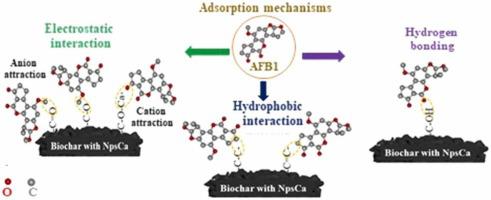Journal of Hazardous Materials ( IF 12.2 ) Pub Date : 2021-09-26 , DOI: 10.1016/j.jhazmat.2021.127339 E O Pérez-Gómez 1 , G García-Rosales 1 , L C Longoria-Gándara 2 , J C Gómez-Vilchis 1

|
This work presents the formation of biochar with calcium nanoparticles (NPsCa) in function of pyrolysis time (C10, C30, C60, C120 and C180 min) using the Citrus tangerine peel and their evaluation in the remotion of Aflatoxin B1 (AFB1) in aqueous phase. Firstly, the Citrus tangerine was studied by Thermogravimetric analysis to determine the optimal temperature (TGA), obtaining a result of 600 °C. The biochar (NPsCa) were characterized by Scanning Electronic Microscopy (SEM) and Energy Dispersive Spectroscopy (EDS), as well as surface properties including the identification of functional groups by Fourier Transform Infrared Spectrometry (FTIR), and energetic states through the X-Ray Photoelectron Spectroscopy (XPS). The adsorption studies were carried out on the different materials and later, the experimental data was adjusted to different mathematical models, obtaining the best fit of the kinetic data to the Ho-McKay model, whilst the adsorption isotherms were adjusted to the model of Langmuir, which indicates that the Aflatoxin B1 adsorption process is carried out through a monolayer chemisorption process with maximum sorption capacities (qm) ranging between 15.72 and 63.22 µg g-1. With the 180th minute being the adequate time to obtain the carbon with the best surface properties and the best adsorption capacity. Additionally, it was observed that each material can be reused up to five times in accordance with the results from the reuse cycles.
中文翻译:

使用 Citrus tangerina 获得 Biochar-Ca 纳米颗粒 A 黄曲霉毒素 AFB1 的形态、表面和研究去除
这项工作介绍了使用柑橘皮形成的具有钙纳米颗粒 (NPsCa) 的生物炭与热解时间 (C10、C30、C60、C120 和 C180 分钟) 的函数关系以及它们在去除水相中的黄曲霉毒素 B1 (AFB1) 中的作用. 首先,柑桔通过热重分析研究确定最佳温度(TGA),得到600°C的结果。生物炭 (NPsCa) 通过扫描电子显微镜 (SEM) 和能量色散光谱 (EDS) 进行表征,以及表面性质包括通过傅里叶变换红外光谱 (FTIR) 识别官能团和通过 X 射线检测能量状态光电子能谱(XPS)。对不同材料进行了吸附研究,随后将实验数据调整为不同的数学模型,得到动力学数据与 Ho-McKay 模型的最佳拟合,同时吸附等温线调整为 Langmuir 模型, 微克-1。 _ 第180分钟是获得具有最佳表面性能和最佳吸附能力的碳的充足时间。此外,据观察,根据重复使用周期的结果,每种材料最多可重复使用五次。











































 京公网安备 11010802027423号
京公网安备 11010802027423号